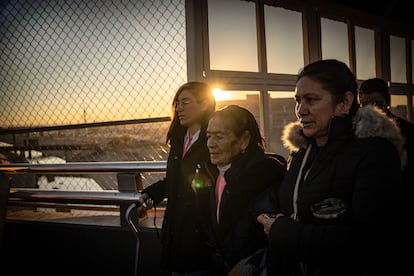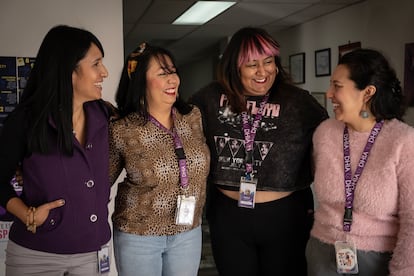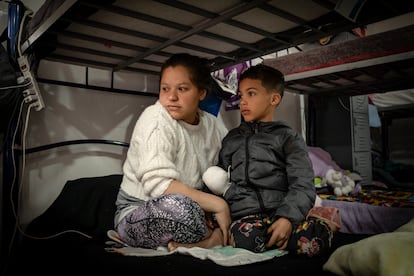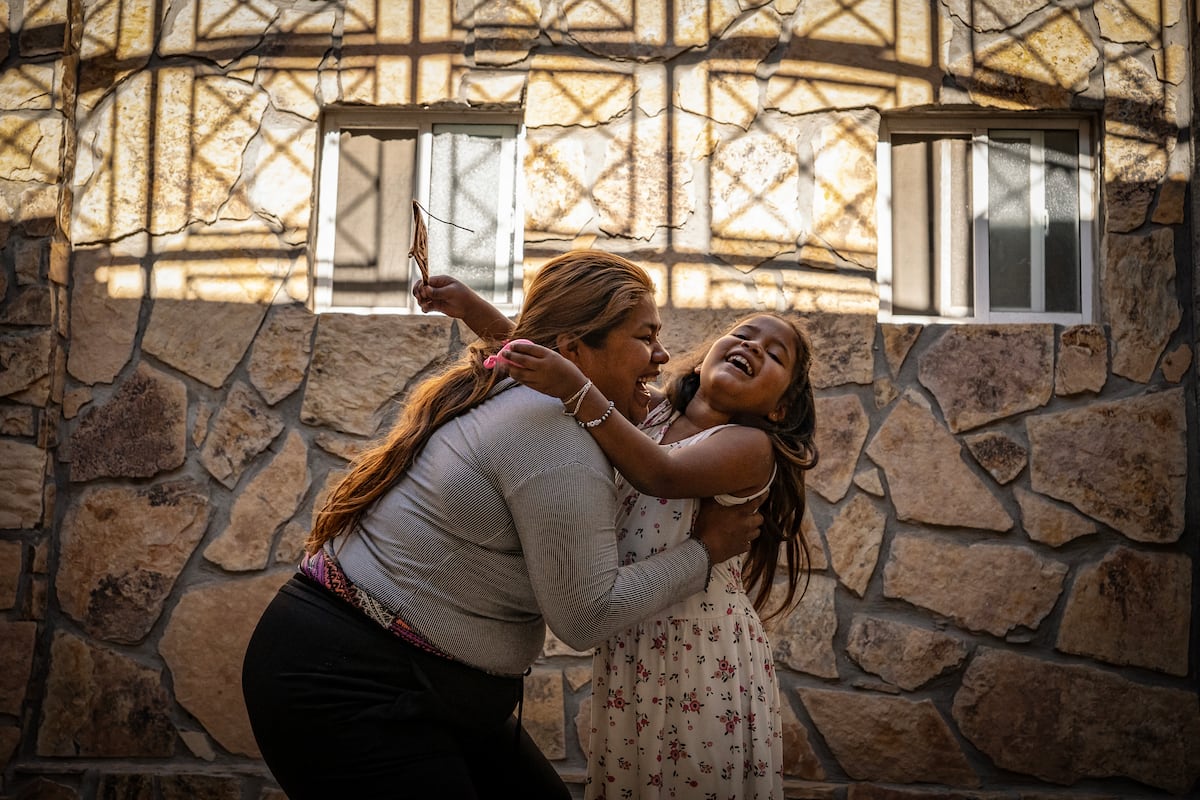Since Donald Trump won the elections for the second time on November 5, for the thousands of migrants waiting in Mexico for the application CBP One give them an appointment to request a humanitarian permit with which to enter the United States, obtaining it has become more urgent than ever. The Government of Joe Biden, which launched this free tool almost two years ago to organize the flow of the thousands of people who arrive at its borders to request asylum, says that the majority get an appointment in less than eight weeks, but many of them Those waiting in Ciudad Juárez claim to have been months without luck in what they consider a lottery; a tombola that has now become a race against time with the goal being January 20, the day on which the Republican, who has promised to end this program, will take office.
“I’ve been waiting in Mexico for a year for my CBP One appointment,” says Damarys Godoy, a Venezuelan migrant who participates every Thursday in an embroidery workshop at the Ciudad Juárez cathedral, while her eight-year-old daughter Carlys , does crafts with a group of migrant children. This 34-year-old woman from the State of Barinas decided to leave Colombia—where she had migrated in 2016, driven by the Venezuelan crisis—with her husband and the youngest of her three daughters, encouraged by a sister who lives in Miami. Now, after crossing the dangerous Darien jungle and spending 12 months in Mexico, he lives with the uncertainty of whether they will be able to cross the border before Trump reaches the White House. “We want to pass legally to give our children a future, but we are afraid because he says he does not love migrants and even more so us, Venezuelans, because some have done bad things.”
Migrants like her wait in fear not only because of Donald Trump’s promises to end CBP One and other permits for humanitarian reasons, which have benefited 1.3 million people, or to undertake mass deportations, but also because of the memories of the first term of a president who has won two elections with an anti-immigrant speech, and who used cruelty as a method of deterrence with policies such as “zero tolerance,” through which thousands of children were separated from their undocumented parents at the border. Six years later, hundreds of these families have still not been reunified because the Government lost track of the parents after deporting them, and it is increasingly difficult to think that they will ever be able to do so.
For this reason, Damarys dreams of getting an appointment before January with which to pass legally and apply for a work permit. “If not, we are going to be very uneasy because we don’t know what will happen to us if immigration from the United States catches us, what will happen to the girl?” he asks. “They can take it away from us because I hear that Trump did that in the past.” While migrants speculate about what will happen once the Republican returns to the White House, the organizations that assist them try to gain strength in the face of the promise of mass deportations, but also in the face of a possible increase in the flow of people before January 20 or by the implementation of new restrictions that bring a new crisis to the border.
A laboratory to “externalize borders”
“We are clear that it is going to be a difficult time. At the border we are used to living in this emergency situation, especially in the last five years,” acknowledges Blanca Navarrete, director of the organization Comprehensive Human Rights in Action (DHIA). This 43-year-old woman who has spent more than half her life dedicated to migrants in Ciudad Juárez recounts the episodes that have overwhelmed the attention capacity of this municipality separated from the Texas city of El Paso by the Río Bravo, and a wall increasingly extensive and with more barbed wire.
First, Navarrete remembers, were the migrant caravans that gathered thousands of people in search of protection on their way north. Then came the Migrant Protection Protocols, through which Trump sent more than 71,000 people to Mexico to wait their turn to request asylum, and through which huge refugee camps were formed on the border line. With the pandemic came Title 42, by which the Republican closed the border citing public health reasons. And they also had to attend to thousands of confused migrants that Washington sent on the so-called “lateral flights,” hot returns of those who had entered the United States illegally through other points on the border.

For Dirvin Luis García Gutiérrez, division head of the Migrant Assistance Program of the State Population Council of Juárez (Conapo), Trump’s presidency was a kind of testing laboratory to “externalize the borders” to other countries than the cities of the northern Mexico they took on as best they could. “The return of foreigners to national territory from the United States is something that has never been seen before and that has never been agreed upon or implemented,” says the Chihuaua State official. For him, the most shocking thing was when they had to receive between 200 and 300 migrants a day on lateral flights: processing so many bewildered, traumatized and sometimes sick migrants exceeded the city’s reception capacity. “That was a real humanitarian crisis. “I think it’s the closest thing I’ve seen to what could be likened to a war,” he recalls.
But Trump’s presidency also left positive things on the border, adds Blanca Navarrete, such as the gathering of activists, religious groups, human rights defenders and international organizations that came to support them. “I remember helplessness because we had never been so on the edge, but at the same time I also remember a lot of solidarity from the people who went to the Santa Fe international bridge with meals for those who were waiting to enter to request asylum,” he points out. “Although unfortunately later that solidarity was eroded, because finally Trump’s hate speech managed to permeate the narrative.”
“The outlook looks complicated because we have noticed how there are obstacles even in getting regularized in Mexico,” acknowledges her partner Ciela Ávila, a 27-year-old daughter of an Oaxacan migrant who arrived in Ciudad Juárez decades ago with the intention of crossing into the United States. United and ended up staying in the border city. “At least from my perspective, the only thing I see of hope is that the strength of the people who are working on the issue does not run out.”

A new emergency?
Now these organizations feel that they are experiencing that calm that precedes the storms. Shelters in the State of Chihuahua are at just over 50% occupancy, according to Conapo data, and there has also been a reduction in illegal crossings to the lowest level since 2020, which organizations attribute in part to the implementation of the application CBPOne, but also to greater control by the Mexican authorities to prevent migrants from approaching the northern border and distribute them throughout the southern states. However, in recent times they have also identified an increase in kidnappings, both at the entrance of Durango to Chihuahua and in different parts of Ciudad Juárez, where they have held more than 100 foreigners in the so-called “safe houses.” , a sign that “organized crime already has this business of human trafficking,” explains Diana Solís, from DHIA. Additionally, a spike in deaths has been seen in remote areas of the desert where migrants are likely being pushed to escape violence and increased border control.
Almost two months before Trump returns to the White House, Juárez is preparing to respond to a possible new emergency at the border. And although they do not believe the Republican’s promise to deport the estimated more than 11 million undocumented immigrants in the United States is feasible, no one seems to ignore that the city is not ready for events like those it experienced in the past. “No shelter is prepared to receive a wave of people,” says Pastor Juan Fierro, director of El Buen Samaritano. “If they plan to deport everyone across the northern border of Mexico, it will be a problem for us in the sense that we do not have the capacity to care. It’s going to bring chaos because they’re going to be under bridges, in abandoned farms where they can take cover right now because of the cold weather and the National Immigration Institute is going to start deporting too,” he says.
In their shelter, which has capacity for up to 180 people, they have reached 250. Now there are only 42, most of them families of Venezuelan migrants, like Bárbara Mendoza, her husband and their children Matías, 8 years old, and Zahira, who was born in the road to Juárez, in Durango, 19 days ago; Central Americans like Fidela Baldano, who fled the Honduran department of Colón 14 months ago with her two daughters, ages 6 and 16, after the gangs killed one son and tried to recruit another; and Mexicans displaced by violence like Itzel, from Iguala (Guerrero), who also migrated with her two children behind her husband, who crossed to the United States after receiving threats from organized crime. “He says we should make the appointment, that they are going to cancel it and what are we going to do,” says the woman who, like the rest of the migrants in the shelter, hopes to get a place to enter the United States with CBP One. “If they remove the program, we don’t know what to do. Only God knows.”









